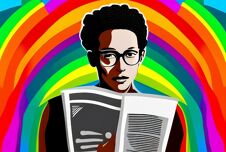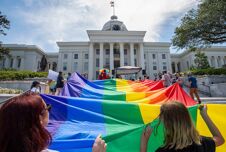There’s a certain excitement surrounding coming out, a substantial weight lifted from your shoulders as you realize you can live authentically in a truth that you’ve known and held close to yourself for so long. Though in both of my experiences coming out, first as gay and then as nonbinary, that initial rush was quickly quieted by the reality of living as an out queer trans person.
When I came out as nonbinary in my late 20s, I couldn’t have imagined how drastically it would alter my dating and sex life.
Related:
Lyft is launching a revolutionary new feature for women & nonbinary people
It won’t take long for other rideshare apps to copy this.
In January 2021, I shared by nonbinary identity with the world. I came out to a number of friends and family first, but in the midst of the COVID-19 pandemic and a recent move, I decided the best way to get the word out was by sharing the news on Instagram and Facebook. It feels like I was as naive coming out as nonbinary and trans as I was 13 years prior when I came out as gay (which eventually morphed into queer) just before my 14th birthday.
Dive deeper every day
Join our newsletter for thought-provoking commentary that goes beyond the surface of LGBTQ+ issues
While I was very literate in the trans experience, I struggled to come out as nonbinary for so long because I understood that it meant I would have to navigate constant misgendering and misunderstanding in my day-to-day life.
Dating, of course, was no exception.
Where dating apps fail
After coming out as nonbinary during the worst days of the pandemic and quietly attempting to build community in my new home in Los Angeles, I was eager to at least get chatting with people, hopeful that I might find someone to safely hang and connect with after months of being mostly isolated following my move the previous year.
I already had experience on a number of dating apps, but revisiting them after coming out felt like something entirely new. The first thing I noticed is that some apps are simply built with nonbinary people as an afterthought.
On Tinder and Bumble specifically, there was an option to add your gender and pronouns to your profile. Great! But upon naming my nonbinary gender, the apps then immediately asked whether I wanted to be shown to people looking for men and/or women, effectively placing me right back into a binary I don’t belong in.
I remember making a TikTok about it at the time that blew up, my page full of comments from cis people essentially arguing why it was important to them to be able to see people they know they would be attracted to. But what about the needs of trans and nonbinary people? If I see you as a potential match, I’d like the assurance that you actually wanted the app to show you people of my gender.
A commenter tried tell me that — as a gay man — there are certain nonbinary people he was attracted to, so this designation helped to filter out the ones he wasn’t. I firmly responded to the comment in a video, “So what you’re saying is you’re OK dating nonbinary people who you view as cis men?”
It blew my mind how self-centered so many responses were. What about my safety and comfort on these apps and the safety of other trans and nonbinary people?
I don’t want to be shown to people looking for men; I don’t want to be perceived as one. Despite what people may think when they see me, I’m not a man. Miscategorizing my gender because of a programming oversight felt like a fast-track ticket to being misunderstood and misgendered in dating and relationships right out the gate.
I’m nonbinary, and I want to be shown to people looking for nonbinary people. Quite the concept.
Raising my standards
I recently redownloaded both Tinder and Bumble to see if anything had changed, and while Tinder is still rocking the same highly outdated, harmful model, I was pleasantly surprised to see that Bumble had made the appropriate updates, adding a nonbinary option for who people are looking for along with an ability to further specify your gender, even under the binary options (i.e. trans man, intersex woman, nonbinary man and woman).
But that lingering programming oversight on Tinder placed me right back into a binary I don’t belong in, and it echoed how I feel every day of my life.
There is the sort of dichotomy that comes with my male privilege despite my nonbinary gender, through no fault of my own and simply due to how I’m perceived by society. I can generally walk around at any time of day and expect not to be cat-called or harassed. My facial and body hair, the shape of my body, and my 6’1” stature create a bubble of protection that I’m well aware is not afforded to others.
In an ideal world, my gender would be understood innately. At the very least, people would have the openness to accept my truth, rather than immediately self-confirming I must be a man, only to be met with another reality and becoming so perplexed that they can never dig themselves out of the hole of their truth regarding my identity.
I had a great time with someone I dated casually throughout 2022, but I found myself having to constantly correct him as he referred to me as a man after sex — even though I’d told him a number of times that I’m nonbinary, no matter what he may perceive when he looks at my body. I told him it was a key part of understanding who I am, of sharing intimacy with me. Still, he continued. Eventually, when I confronted him again, restating the importance of recognizing my identity, our conversations fell off and we never saw each other again.
I see a nonbinary person in the mirror. I am often affirmed when hearing cis people talk about their experiences with gender and realizing I truly can’t relate. Not that gender identity and expression must be linked, but I see my gender, my navigation between and beyond the feminine and masculine, expressed in everything I do and show the world.
Still, I could be in a full on dress, a makeup-clad face, fully femming it up, and I’ll still be seen as a man. I recognize this is something that binary trans people and folks who pursue gender-affirming care also face all the time — no matter how feminine or masculine they present themselves, people will bend over backward to put them back into a box they don’t fit in.
If anything, this shows how far society has to go to break the constraints of the gender binary, that these very clear indications of someone’s identity get so easily, and I’d argue often intentionally, overlooked.
I understand that everyone is essentially deprogramming their understanding of gender at their own pace. But when it comes to dating, I shouldn’t have to constantly educate or correct. In fact, I’d prefer to enter a potential connection with the understanding that my date doesn’t have to overcome a barrier simply to understand my identity and that it isn’t up to me to teach them how.
It’s easy to see the difference with some of the partners I’ve had this year after simply raising my standards for how I wanted to be treated. I was dating a transmasculine nonbinary person at the start of the year, and I simply didn’t have to explain much at all about my gender, nor did they.
When we talked about gender and identity, it was often in an abstract sense, about navigating the world as a gender-nonconforming person and exploring some of our shared frustrations in that journey, which ultimately brought us closer together. We didn’t have to explain the nuances of our gender identities — it was simply an innate understanding we shared, even though our experiences with gender were still different.
One of my current partners, a cis man, similarly involves far less labor than the others I’ve been with in the past. I can see that he’s done the work. He’s always gendered me correctly, and he recognizes that I’m nonbinary and what that means for how I show up in the world.
One time at dinner, I was explaining some of these points to him, the relief that I can just be myself around him and how consistently other people I date seem to place their own presumptions on my identity and experience. Rather than starting to explain how hard it is for him to shift his perspective or drilling me with additional questions, he simply thanked me for helping to inform his perspective on our relationship and how I exist in the world as a nonbinary person.
Meeting People IRL
Even in online spaces where I can properly identify my gender, I have repeatedly seen a lack of understanding for trans and nonbinary people in action. You can’t solve this problem by quickly changing an app setting.
I’ve gotten blocked in real-time when disclosing my gender over chat (even though it’s already all over every dating app profile I have). I’ve had cisgender people affirm that they were accepting, only to never be properly gendered in person and met with annoyance or indifference when I correct them. Also, all of those connections have since fizzled out — telling me that someone’s genuine understanding and respect of my gender was too hefty of a price for getting to date and/or have sex with me.
When I bring up this topic, it often elicits a defensive response from cisgender people, but nonbinary and trans people aren’t forcing anyone to date or sleep with us. Most of us would rather not if it’s going to be a point of contention, and that’s also a reason many trans people (myself included) prefer other trans partners.
It’s also worth mentioning that the online dating formula is flawed as a whole. It’s based on quick judgments, on gut feelings, on a profile description with a character limit. There isn’t much room to really dive into the person I am, or to fully vet and understand the person I’m talking to, through a phone screen.
Gender and sexuality aside, I’ve talked with a lot of people my age who have had it with the current dating model, longing for a time when we could go to a public space and expect to just meet new people the old fashioned way. As we continue climbing our way out of the COVID-19 chapter, rather than tirelessly trying and failing on dating apps, I’ve decided to focus on meeting people IRL and building community, with the hope that I’ll find some solid connections to explore.
Lo and behold, I already have. At the start of 2023, ready or not, I decided I would simply begin living the life I wanted to live. I began consistently going to LGBTQ+-focused dance events, even if it meant going alone. I started simply chatting with strangers, realizing that most people were just as eager to pursue new connections as I was. Many of those conversations led to more permanent connections, finding one another online and at future events. Some of those connections ultimately went even further.
I had my first experience making out on the dance floor with a stranger over the summer, which culminated in a sexy sleepover after the rave concluded. The context of the event, and the way I was dressed, made it easy to disclose and talk about my gender. It ultimately wasn’t a big deal at all; we just shared a mutual attraction for one another. At another event, just telling a girl that she looked cute resulted in a hot, touchy dance that persisted throughout the night. I was dressed as queer as can be, shared my pronouns, and if anything, she seemed more attracted to me. We exchanged Instagram handles and have kept up with each other since.
Simply keeping myself open to new connections with affirming people in spaces that cater to the broader LGBTQ+ community has not only drastically expanded my community as a whole but established my current handful of relationships, six partners with whom I share varying levels of physical and emotional intimacy and around whom I feel safe to be my authentic self.
As a nonbinary person who’s only been out of the closet for a couple of years, I’m recognizing that trans people don’t have to settle for people who can only understand our experiences through the context of an antiquated binary or their own lens.
It can take time, work and discomfort — a number of potential detours or even paving our own paths — but it’s worth exploring to find those people who truly see us as we are.
















Dating as a nonbinary person can often feel impossible. But I won’t settle for less than I deserve.